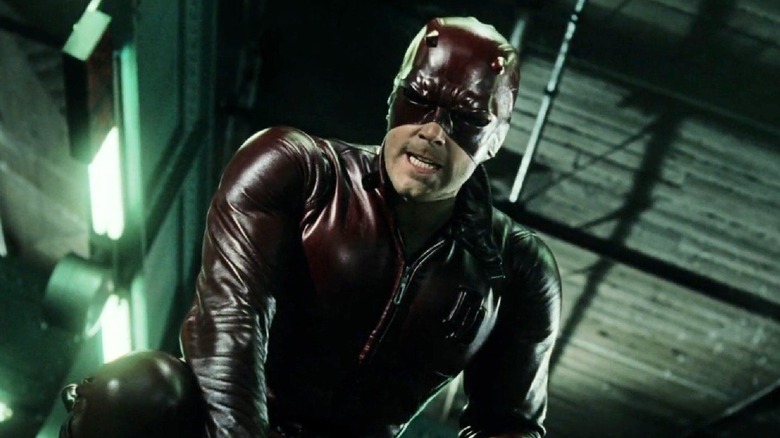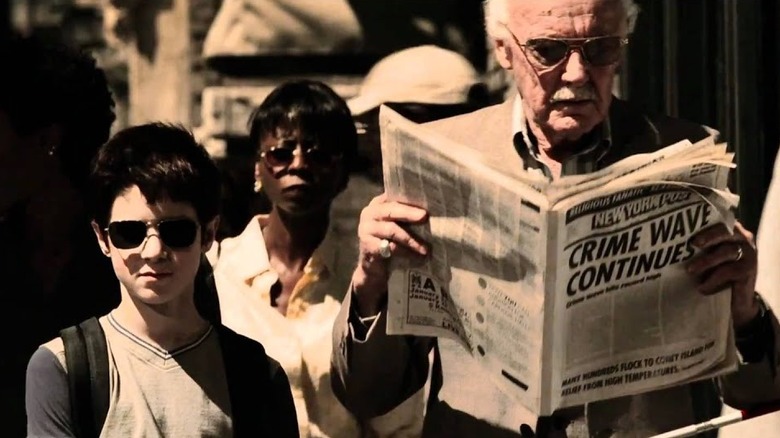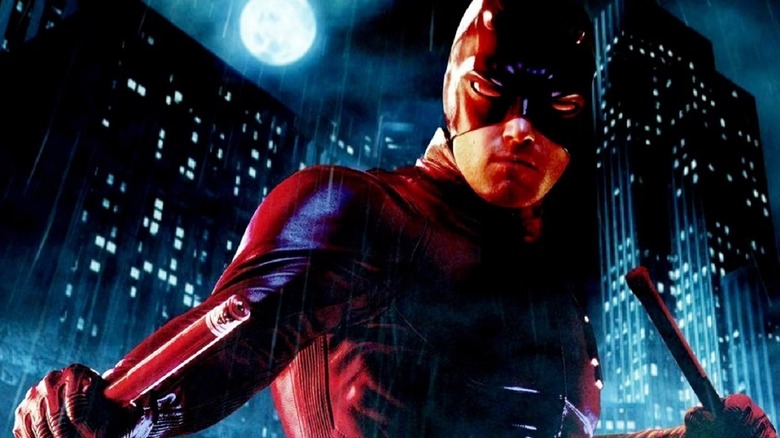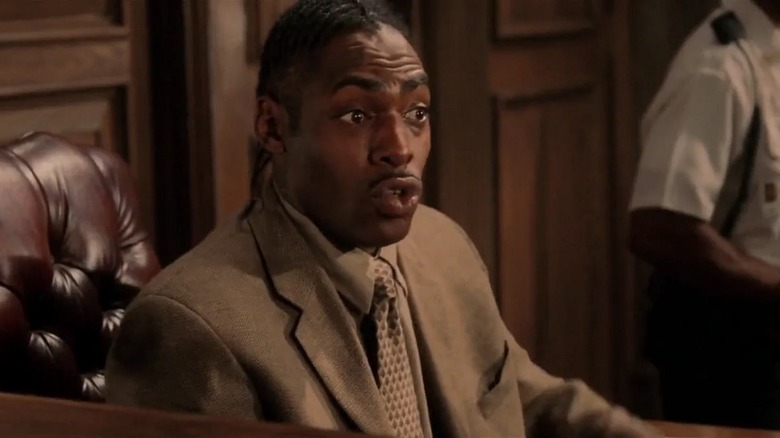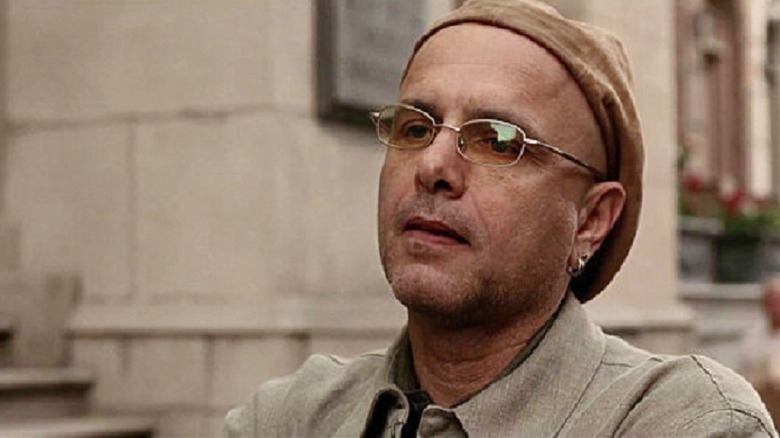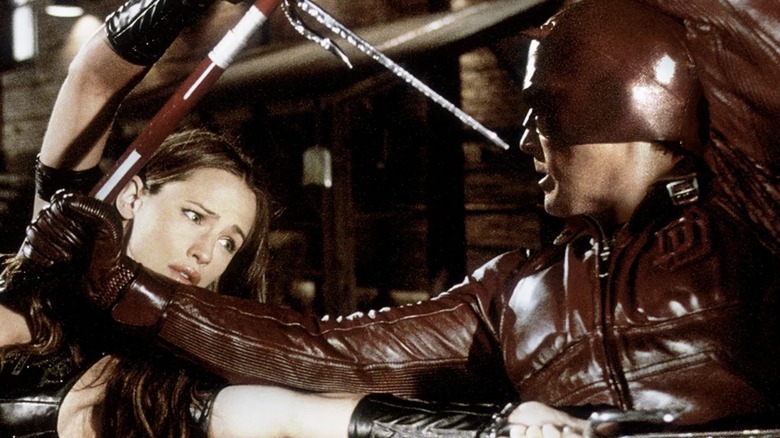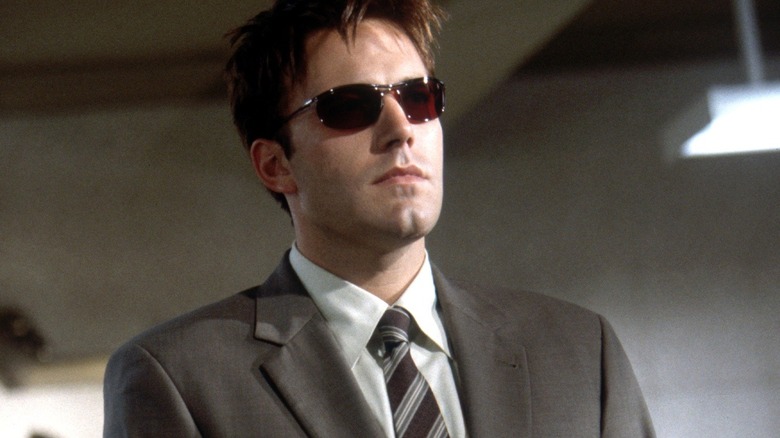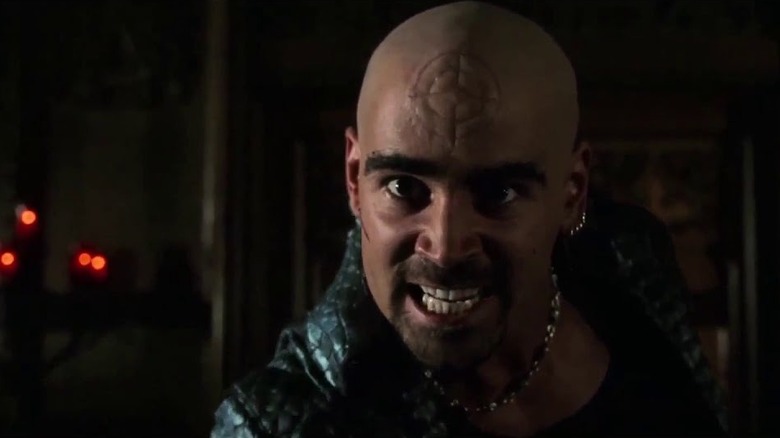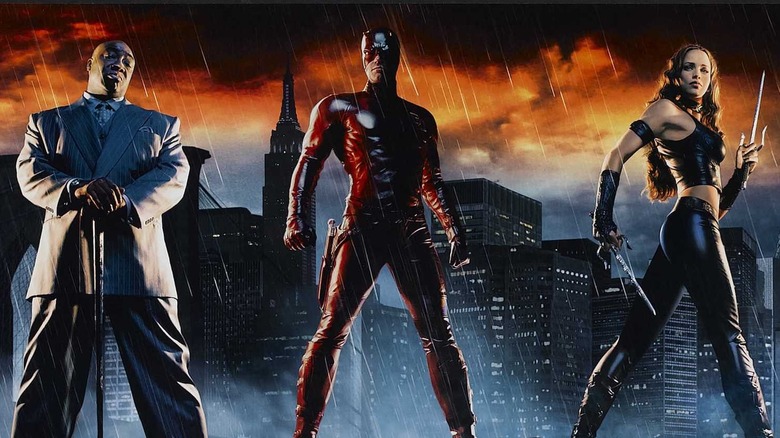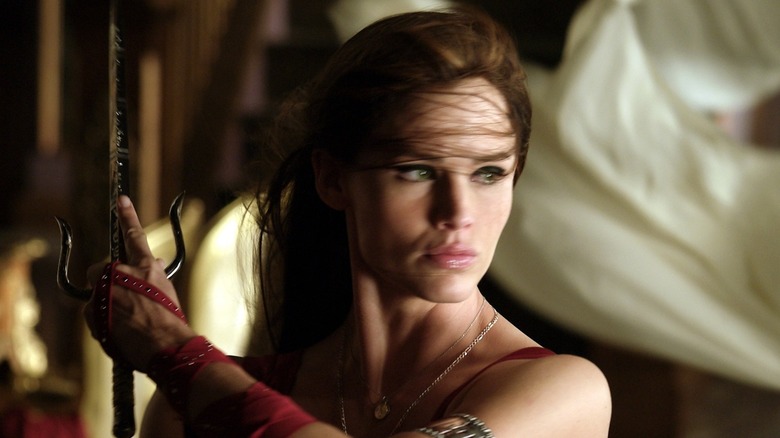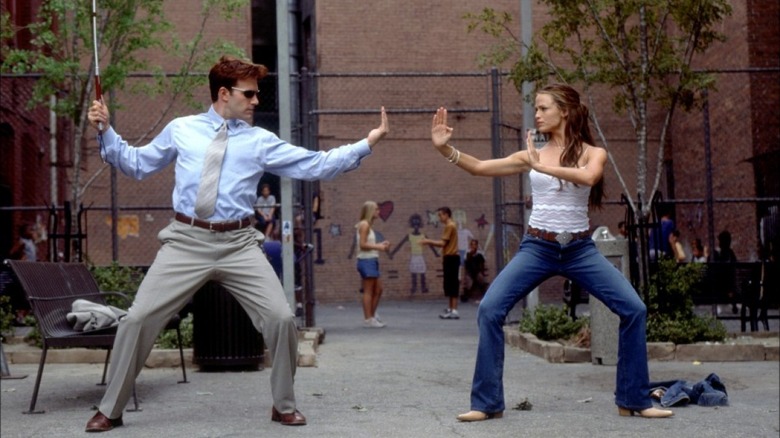Daredevil: 10 Facts About The 2003 Marvel Movie That Hit The Bullseye
On February 14th, 2003, Ben Affleck debuted as the first big-screen version of the Man Without Fear in "Daredevil," attempting to bring justice to the world of comic book movies on the heels of successes like "Blade," "X-Men," and "Spider-Man." But the Devil of Hell's Kitchen didn't fare nearly as well as his Marvel peers. Upon the release of "Daredevil," fans felt let down and critics were mixed, with even positive reviews saying the narrative was overcrowded, its CGI was painful, and the action scenes were sloppy.
In the years since, it seems like many have softened their stance (via FandomWire) on this film and its origin story of Matt Murdock, the blind lawyer turned superhero. With the subsequent release of a director's cut, the wonky editing and rushed plot appear to be a result of studio meddling (according to Den of Geek), while a reassessment of the performances has many appreciating Affleck's dedication to the role, Colin Ferrell's antics as Bullseye, and how Michael Clarke Duncan'intimidating presence made him a great choice to play Kingpin. The soundtrack is also surprisingly good — people were likely just getting tired of hearing Evanescence in 2003.
Looking back on the film, it's hard not to find "Daredevil" more interesting than it appeared upon its initial release. Here are some of the things that people might not know about the biggest outing Daredevil has had so far.
Comic creators referenced
It has become a tradition in many ways to put sly references, obscure cameos, and name-drops to the real-world creators of comic book characters in their films, but "Daredevil" may have been going for a record to see how many they could stuff into one movie. Everyone expects the Stan Lee cameo, as the man who helped co-create Matt Murdock is seen almost walking into traffic until a young version of our hero stops him. Lee is also mentioned as Mr. Lee, one of Matt and Foggy's clients, who pays in fish. A more commonly missed cameo is writer Frank Miller, but he may be hard to recognize with the pen in his head. Kevin Smith, who wrote a few Daredevil comics himself, plays a lab assistant named Kirby, in reference to artist Jack Kirby.
Many other small characters have meaningful names. Father Everett is named for Bill Everett, Daredevil's other co-creator, while the criminal Jose Quesada is named after former Marvel editor-in-chief Joe Quesada. There's also the henchman called Kane, in honor of Gil Kane, a cover artist for many "Daredevil" comic books. The remaining important figures are hidden as a laundry list of boxers associated with Jack Murdock: (Gene) Colan, (Frank) Miller, (David) Mack, (Brian Michael) Bendis, and John Romita, who is a nod to a father-and-son duo of comic artists who both worked on "Daredevil" at different points.
The director's cut
It's never fun to hear that a movie we wanted to love was the victim of studio interference, but this was a bullet even "Daredevil" couldn't dodge. The film did thankfully receive a director's cut, adding over 30 minutes of footage to the film. According to the Giving the Devil His Due: The Making of Daredevil Director's Cut featurette, director Mark Steven Johnson and producer Avi Arad said this R-rated version of the film was closer to what they originally wanted to release into theaters — minus the nudity and more brutal violence from the original script — before extremely late changes were made to appease the studio by lowering the rating to PG-13 and adjusting the pacing. Johnson told ComicBook.com that while the extended version still isn't perfect, it's the preferred way to watch for many who didn't connect with the theatrical cut — even if it doesn't fix several of the movie's problems, viewers seem to like it more.
The theatrical version has more gaps that make the film feel lacking in the plot department, and additional scenes had to be shot to cover these changes. Not only does this version add back an entire dropped subplot and more Foggy Nelson, but it also extends many of the fight scenes, which helps balance out the movie's overall tone. Several portions of the battle between Elektra and Bullseye had to be trimmed down due to the amount of violence that was shown against the main female character (via CineNation).
The deleted subplot
Some fans were confused when they saw teaser trailers for "Daredevil" featuring scenes with Coolio, who was not present in the theatrical cut of the film. This wasn't just a small cameo, but rather an entire subplot that would have focused more on Daredevil's work as a lawyer. Fans would have seen Matt Murdock defend Dante Jackson, played by Coolio, who is framed for murder. The cop at the center of the incident is hard for Daredevil to read: usually, the hero can tell when people are lying, but this is difficult due to the policeman having a pacemaker, making the case more difficult. A similar event happened in "Daredevil #184," from which the inspiration for this story may have been taken.
So why was this subplot removed? Mostly it seemed to have hit the editing room floor due to the film's length, as well as the fact that taking out a more serious section helped achieve the PG-13 rating. However, some viewers believe (via Reddit) that while this material may have fit the tone the filmmakers were originally aiming for, it's also a bit boring, and like this Decider article says, makes it abundantly clear that Murdock is a much better vigilante than he is a lawyer. For those who want to find out for themselves, this is one of the major elements added back into the director's cut of the movie and may help enrich the experience.
Minor comic characters
This movie is already overstuffed with characters: Not only do we have Daredevil, Elektra, Bullseye, and Kingpin to worry about, but there are several other important figures from the comics that barely get any screen time. We get a little bit of reporter Ben Urich. He usually works for the Daily Bugle, but since the studio didn't have the rights to Spider-Man, this was left out, giving the underdog investigative journalist played by Joe Pantoliano less to do (via IGN). Someone who was disrespected much more was Karen Page (Ellen Pompeo), a notable figure who was allowed to shine on the Netflix series, but is easy to miss in the film. Considering the lack of prominent female characters in this movie, neglecting her feels like an even bigger slight.
In the film, Matt Murdock checks his voicemail only to hear his irritated girlfriend breaking up with him. But her character is actually a deep cut for fans of the comic. Heather Glenn was prominent in writer Frank Miller's run and the two characters broke up there as well, so this seemed fitting. The other small character that gets a nod — and is also given more attention in Marvel's Netflix universe — is Turk Barrett, a small-time criminal mentioned only in the director's cut by Coolio's Dante Jackson. Each of these characters is worthy of being included, but their presence does mean that "Daredevil" is a little overcrowded at times.
Lining the devil's pockets
This version of "Daredevil" started as a much different project. Originally, the movie was meant to be smaller and aimed at a more adult audience, with extreme violence and even nudity, but another superhero changed the future for the Devil of Hell's Kitchen. The success of 2002's "Spider-Man" opened a few eyes at 20th Century Fox, convincing the studio to raise the allotted budget by $30 million in an attempt to compete (via Los Angeles Times). The hope was that the additional money would help upgrade the film's visual presentation, but this supposedly didn't happen until filming had already begun on the project.
This is why the film ended up with more wirework, the memorable (but not always for good reasons) fight on the playground with the two heroes in street clothes, and a copious amount of bad CGI, according to MovieWeb. These elements would have most likely been handled differently or left out completely with the smaller budget, but the success of "Spider-Man" caused executives to see dollar signs. "Daredevil" didn't do horribly at the box office, but it certainly couldn't reach the amazing numbers of "Spider-Man." Whether or not the extra finances actually helped the quality of the movie is up for debate, but the added budget and bolstered marketing certainly got more eyes on the movie, giving attention to a lesser-known character.
Playing blind
One of Daredevil's defining characteristics is that he was the first — and still one of the few — blind superheroes out there. Director Mark Steven Johnson spoke about how hard it was to explain that aspect of the character to people who had never heard of him before, but it is a major thing that can't be ignored when making "Daredevil." Yes, Affleck was virtually blind as a result of the contacts he wore while filming, but there needed to be a bit more than that (via Dark Horizons).
There are a lot of nods to Matt Murdock's experiences as a blind man outside of the ties to his superpowers. One thing that sticks out is watching him fold money in different ways so he can tell the various bills apart by touch. Many of these details were thanks to the production bringing on consultants from the blind and visually impaired community in an effort to make Affleck's character feel more authentic (via CineNation).
The devil's wardrobe
Costumes have been a sore subject for comic fans ever since studios began making movies about their favorite heroes. The arguments about these outfits haven't raged hotter than when the X-Men didn't show up in yellow spandex, but each new film inevitably has people critiquing fabrics and scrutinizing tiny details.
According to the Beyond Hell's Kitchen documentary, months of work were put into Affleck's costume as the crew and studio executives agonized over the look, from the horns and pads down to lengthy discussions over the specific shade of red used. Affleck suffered to make sure the character looked right, not only going through the process of making full-body molds, but also wearing contacts that affected his vision heavily, making filming more difficult.
Jennifer Garner's costume for Elektra is criticized more for not looking close to the original character, but some solid points were brought up about wearing thin red satin in an action-heavy movie. That costume wouldn't have made it easy to hide the harness required for many of the stunts, and the leather provided much more protection when pulling the actress around for wire scenes. Garner mentioned getting cut and bruised during the fights even with a sturdier costume, so having less padding would have certainly made it worse. Aesthetically, the choice to have her in black leather seemed to be made in an attempt to be more realistic, and to not have her look like she was copying Daredevil by wearing the same shade of red.
Switching up the actors
Often the actor who makes it to the screen in a main role wasn't necessarily the first person considered for that character. It's a fun distraction to speculate how different a movie would be if the first person approached took the job, seeing as many scripts are changed to fit the individual playing the role. "Daredevil" was no different, as many hot commodities were considered for the primary cast, but a few of the names stand out.
For the Man Without Fear himself, Matt Damon was approached, but he's said to have had no faith in the script and didn't know the director, leaving the path open for his friend Ben Affleck (via Project Casting). Before that happened, however, Vin Diesel was strongly considered for the role, and was also floated for the character of Bullseye, but he had his own reasons for refusing (via MTV). Many of the roles were swapped, as Affleck was originally up for Bullseye, while Colin Ferrell auditioned for the hero. How different would the film be had they stuck with their original roles?
Several wrestlers were looked at to bring Wilson Fisk to life, but once Michael Clarke Duncan was considered, producers believed he was the perfect choice for Kingpin. Elektra likely had the most candidates, with actresses like Eliza Dushku, Neve Campbell, Penelope Cruz, Lucy Liu, Katie Holmes, Salma Hayek, Jessica Alba, Jolene Blalock, and even Natalie Portman allegedly considered for the role (via Fandom).
Daredevil rides again
After the film's release, a sequel was heavily discussed and these conversations continued for years (via Fandom), with several names involved with the first film showing interest in returning for another outing. But eventually, Ben Affleck decided that he might be done with blockbuster superhero films. At the 2006 premiere of his film "Hollywoodland," the star said, "Wearing a costume was a source of humiliation for me and something I wouldn't want to do again soon" (via SlashFilm). Affleck did take up the role of Batman in 2013, but before that, he portrayed Daredevil one other time in a way many fans missed initially.
The other factor in "Daredevil 2" not being seen as a viable property was the absolute failure of the franchise's spinoff, a solo adventure for Elektra. Released in 2005, "Elektra" supposedly had a rushed and tough production, which shows in the finished product. Even Jennifer Garner reportedly thought it was awful, according to an US Weekly interview with "Alias" co-star Michael Vartan (via E! News). Hidden deep in this poor excuse for a follow-up, however, is a deleted scene that didn't even make the theatrical cut, but was released later to show Elektra reuniting with Matt Murdock. Affleck's cut cameo isn't anything special, but director Rob Bowman explained to IGN that there was no time or ability to do anything more with him. Nevertheless, it did allow Affleck's version of the hero to be seen one more time.
Love hurts, even for superheroes
We have to take a moment to give credit to Jennifer Garner and Ben Affleck for doing so many of their own fight scenes and stunts (via CineNation), but there was one particular flirty scene that the lead actor probably wasn't ready to suffer for. When most think about the "Daredevil" movie, the infamous playground scuffle, involving Matt Murdock's aggressive dating techniques, is usually what people who haven't seen it in years recall. This part of the movie took four days to film and resulted in Garner kicking her co-star a little too hard, causing Affleck to black out momentarily (via Twitter).
They say love hurts, and maybe this small bit of rough-and-tumble playfulness set the sparks off. Although Garner and Affleck had worked together before "Daredevil," something must have hit differently here. A romance was launched, leading to the couple being married from 2005 to 2018, even though both individuals were in other committed relationships at the time of filming. Although some people think Affleck seems bored (via EW) in a few scenes of the movie, knowing this bit of behind-the-scenes information explains why some of the encounters between the two actors feel like they have genuine chemistry. It also makes one wonder: if one of the many other women who were up for the role had played Elektra instead, would Affleck still have ended up with a new wife?
